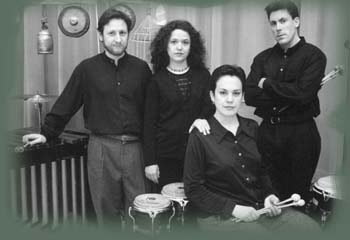- Homestead
- Music and Text
- The CD's
- Who we are
- How we work
- Reviews
- Upcoming events
- Order
- Contact us
- Links
Music and Text

Music and text have been both allies and enemies throughout history.
The earliest written accounts of music making are concerned with the texts linked to it,
and numerous ancient treatises are dedicated to the question of whether music or text should
predominate. These often included specific music tricks (scales, melodic ideas, instrumentation,
and rhythmic patterns) which would enhance the text by eliciting the appropriate emotions.
Others argued that texts enslave music by forcing it into a solely accompanimental role.
« Music could highlight what the text wanted to hide, ignore what the text wanted to stress...»
The conflict, derived from the hopeless asemantic nature of music and the tendency towards representation of most texts, suggests many roads for its resolution.
One thing, however, is clear to us: once the text enters the realm of interaction with music, it never the same. As Pierre Boulez wrote, once a text is set to music, it may even become foreign to its author. The result is a new text with a new layer of meaning. Music could highlight what the text wanted to hide, ignore what the text wanted to stress, or even separate words from one another, creating a dramatic timing nonexistent in the original text.
It is similar to how colors work for painters, once two colors are put together, they are never the same again, they suffer irreversible alterations. Text also has this effect on music: no color is stainless.
The resulting conflict, the arena of this battle of mutual modification, is the heart and soul of the relationship between music and text. Lake Affect is aware of this, and committed to explore it.
Lake Affect bases its work on collaborations with poets and writers in order to enjoy this dynamic puzzle. Each writer creates a unique world, a plane which, when intercepted and multiplied by the already tridimensional musical perspective of Lake Affect, explodes into the unknown.
Last modified: September 8th, 2001.© Lake Affect